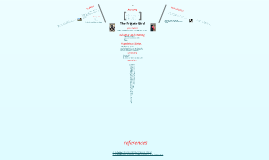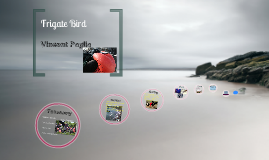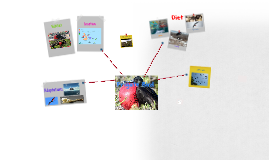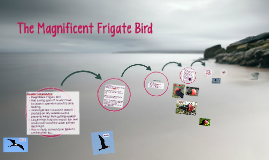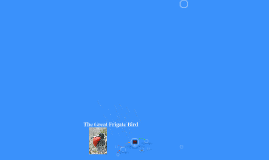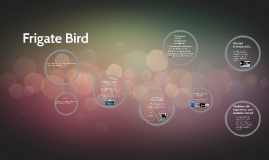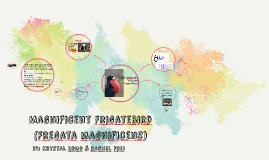Frigate Bird
Transcript: -Courtship occurs between August and October -Males gather in groups and do a multitude of behaviors to attract females. -Females build while males gather -One egg is laid -Parental care differs between male and female Frigate Birds. -Only seabirds known on which sexes breed on cycles of different lengths BY: Krystal Romo & rachel Frei -Wing span allows them to stay flying for extended periods of time. -Little need for wing flapping. -Effortless flight allows for long distances to be covered with minimal energetic cost. -Mozambique Channel Study ( Henri et. al 2004) Info Sources Male vs Female - Large species of Sea Bird found across all tropical and subtropical oceans -Unable to to walk well; has short legs and very small feet causing awkward movement on land -Unable to swim, which directly affects its choice of diet - Their plumage lacks a waterproof coating -Color: Black, White, Brown, Red -Lifespan: 15-25 years -Wing span- 150cm - 250cm (59in - 98in) - Lifestyle: Colony -Male: entirely black plumage, glossed green on the head, with bare patch of skin on lower chest, known as the gular sac. -Can be inflated into bright red balloon-like an organ. -Female: larger than Male -white patch across breast and upper belly, entirely white head then black. -lacks gular sac, and has less glossy, brownish-black plummage Kingdom: Animalia Phylum: Chordata Class: Aves Order: Pelecaniformes Family: Fregatidae Genus: Fregata Threats Diet Fun Facts Habitat Habitat -Found in tropical oceans and coincides with the trade winds. -They breed on strands of mangroves on coral reefs, bushes on dry islands, and along coasts. *Man-O'War-Bird *Pirate Bird *Frigate Pelican Classification Magnificent FrigateBird (Fregata magnificens) Taxnomy Conservation -Relatively large population and is not currently considered to be globally threatened -As a result of human disturbance, habitat loss and the introduction of non-native predators, several historic colonies have been wiped out. -Losses have been most severe in the Caribbean, where an estimated 50 percent of the colonies have been destroyed. - There heavy reliance on food brought to the surface by underwater predators such as dolphin and tuna, which are themselves being driven to extinction, could have serious consequences for this species -Carnivorous -Airborne flying fish, squid, jellyfish, small sea turtles, tiny molluscs and scraps discarded by boats -Sometimes they harass other bird species -Kleptoparasitic Study (Vickery & Brooke 1994) -Their predators consist of cats, rats, and predominantly humans Who is this Bird? Image sources https://www.allaboutbirds.org/guide/Magnificent_Frigatebird/id http://tolweb.org/Fregatidae http://science.sciencemag.org/content/320/5884/1763http://www.arkive.org/magnificent-frigatebird/fregata-magnificens/ Vickery J. A, Brooke M. L. (1994) The Kleptoparasitic Interactions Between Great Frigatebirds and Masked Boobies on Henderson Island, South Pacific. The Condor 331-40. doi:10.2307/1369318 Weimerskirch H., Corre M., Jaquemet S. (2004) Foraging strategy of a top predator in tropical water: great frigate birds in the Mozambique Channel. Marine Ecology Progress Series. 297-308. doi:10.3354/meps275297 Breeding Behavior Biology -Many magnificent frigatebird colonies are protected by written laws, but rarely enforced. - There is a lack of funds, colonies are not patrolled -No method to punish those breaking the law -Improved protection and enforcement of existing laws, particularly in the Caribbean colonies, is therefore necessary to ensure the survival of this remarkable bird -Largest species of Frigate Bird -Frigatebirds are the only seabirds where the male and female look strikingly different -Charles Darwin dubbed this species “the condor of the ocean” http://www.mountainsoftravelphotos.com/Galapagos%20Islands/Day%202/slides/Galapagos%202-1-14%20North%20Seymour%20Young%20Frigatebird.html https://www.bing.com/images/search?q=frigate+birds&view=detailv2&&id=D2B0B91709CC1602784B0EA41211DC3B4ED2AC44&selectedIndex=8&ccid=GjORf4Yy&simid=608007687488799067&thid=OIP.M1a33917f8632db41187ea200832d183co0&ajaxhist=0 https://rollingharbour.com/tag/frigatebird-male/






